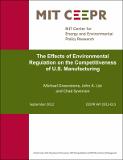| dc.contributor.author | Greenstone, Michael | |
| dc.contributor.author | List, John A. | |
| dc.contributor.author | Syverson, Chad | |
| dc.date.accessioned | 2012-09-17T17:36:25Z | |
| dc.date.available | 2012-09-17T17:36:25Z | |
| dc.date.issued | 2012-09 | |
| dc.identifier.uri | http://hdl.handle.net/1721.1/73009 | |
| dc.description.abstract | The economic costs of environmental regulations have been widely debated since the U.S. began to restrict pollution emissions more than four decades ago. Using detailed production data from nearly 1.2 million plant observations drawn from the 1972–1993 Annual Survey of Manufactures, we estimate the effects of air quality regulations on manufacturing plants’ total factor productivity (TFP) levels. We find that among surviving polluting plants, stricter air quality regulations are associated with a roughly 2.6 percent decline in TFP. The regulations governing ozone have particularly large negative effects on productivity, though effects are also evident among particulates and sulfur dioxide emitters. Carbon monoxide regulations, on the other hand, appear to increase measured TFP, especially among refineries. The application of corrections for the confounding of price increases and output declines and sample selection on survival produce a 4.8 percent estimated decline in TFP for polluting plants in regulated areas. This corresponds to an annual economic cost from the regulation of manufacturing plants of roughly $21 billion, which is about 8.8 percent of manufacturing sector profits in this period. | en_US |
| dc.language.iso | en_US | en_US |
| dc.publisher | MIT CEEPR | en_US |
| dc.relation.ispartofseries | CEEPR Working Papers;WP-2012-013 | |
| dc.rights | An error occurred on the license name. | en |
| dc.rights.uri | An error occurred getting the license - uri. | en |
| dc.title | The Effects of Environmental Regulation on the Competitiveness of U.S. Manufacturing | en_US |
| dc.type | Working Paper | en_US |
| dc.identifier.citation | WP-2012-013 | en_US |
